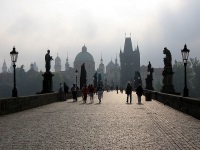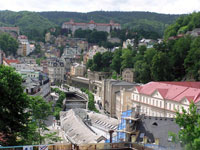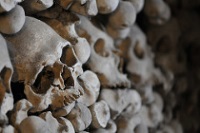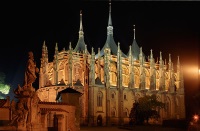Sightseeing in the Czech Republic gets you the very best of classical Europe combined with the country's undeniable charm. Most visitors spend their time almost exclusively in Prague, enjoying the beauty of the medieval buildings and evocative scenery of the river-front location, while sampling the cultural delights of the dynamic live music and theatre scene. Attractions in this beautiful city include Charles Bridge (the most photographed feature of the city), the Old Town Square, St Vitus Cathedral, and numerous incredible buildings in the Castle District on the hill above Prague.Beyond Prague is a host of delights often neglected by visitors. These include world-class attractions such as picturesque Cesky Krumlov, the fascinating ossuary of Kutna Hora, and Karlsbad, the queen of the Czech Republic's many spa resort towns. The Czech Republic also boasts some wonderful hiking trails and scenic areas, which make it the ideal destination for those who enjoy travelling on foot. The countryside is dotted with numerous castles, keeps and medieval villages.The most popular time to visit is over the peak summer months of July and August, although Prague in particular can get very crowded. Spring - April to June - has mild weather and warm days and is probably the ideal time to visit.

Nestled on the winding River Vltava, Cesky Krumlov's appearance has remained almost unchanged since the 18th century. This small, medieval town in southern Bohemia is a bouquet of cobbled lanes, ramshackle red-tiled roofs and colourful houses, all of which provide picture-perfect photo opportunities. Only about two and a half hours outside of Prague, Cesky Krumlov is a wonderful weekend trip or overnight excursion. However, the charming town and beautiful countryside could easily occupy visitors for many days. One of Cesky Krumlov's most famous attractions is the Renaissance-style castle on the hill. It is a trove of covered walkways, courtyards and terraced gardens, and has a history leading back to the 13th century. Castle visitors can expect marvellous views of the town setting. Other famous attractions in Cesky Krumlov include the Egon Schiele Art Centrum, the Church of St Vitus, and the Czech Marionettes Museum. Since the town was designated a UNESCO World Heritage Site in 1992, the summer months have become somewhat crowded. That said, its charm is undiminished.

Visitors to Prague enjoy photographing The Charles Bridge more than any other feature in the city. Built to replace the Judith Bridge (which had been washed away by floods in 1342), its construction began in 1357 and concluded in the 15th Century. Up until 1841, it was the only bridge in Prague, and the only means of crossing the Vltava River. The Charles was closed to traffic in 1978 and has been a pedestrian bridge ever since.The bridge's 30 statues of saints were originally erected between 1683 and 1714, and create a unique combination of Baroque and Gothic styles. A festive crowd usually strolls across during the day, with throngs of people picking their way through the happy mix of buskers and artists. The bridge is far quieter at night, though, when the crowds have left and only the statues stand guard. Under moonlight, the setting presents some beautiful photo opportunities.
Transport : Metro to Staromestská or tram 17, 18, 51 or 54

Elegant boulevards, elaborate colonnades and brightly coloured buildings line Karlovy Vary's picturesque river valley, testifying to the town's history as a getaway for the aristocracy. It is, indeed, the queen of the Czech Republic's many spa resort towns. Tourists typically visit for health purposes, with the town's 12 hot springs garnering most of the attention. Their mineral content is famously rich in restorative and healing properties, drawing guests as blue-blooded as Tsar Peter the Great over the course of their history. Today, locals gather to fill their quaint little drinking cups, sipping as they strolling to help the water work its magic on their digestive tracts and metabolic disorders. As an alternative, many people appreciate the locally made Becherovka liqueur, which is often hailed as the 13th spring. Although most of the spa pools and sanatoriums are reserved for people undergoing treatment, visitors can still swim in the heated pool above the Thermal Sanatorium. Also, Karlovy Vary has plenty of excellent accommodation, unique souvenirs and myriad relaxing activities.

The Kostnice Ossuary, also known as the Sedlec Ossuary or the Church of Bones, is a unique experience for intrepid travellers. The medieval Gothic chapel is decorated with the remains of about 40,000 human skeletons, including an immense chandelier. While it is considered macabre by some, the skeletons belonged to people who wished to be buried in the Ossuary, which they considered a holy place. According to the display, they were all victims of the plague.The famous chandelier contains at least one example of every bone in the human body and, despite its somewhat gruesome building material, is a truly impressive work of art. There are other sculptures and decorations pieced together intricately with bones and the effect is remarkably artistic. Having said that, the Ossuary is a sacred place and the atmosphere is one of worship and peace. The effect of death turned into art is, indeed, a fascinating example of religious devotion and faith as well as a unique work of art. It's worth reading up on the history of the ossuary and the area before visiting the chapel as the experience is greatly enriched by some background knowledge.
Website : www.sedlecossuary.com

In the 14th century, Kutna Hora was the second biggest town in Bohemia (after Prague) due to the discovery of silver ore in the surrounding hills. Today, visitors come to appreciate the history of a once booming place, and to marvel at its architecture. Kutna Hora is, unsurprisingly, a UNESCO World Heritage Site. Its greatest monument is the exquisite church of Santa Barbara, built to rival Prague's St Vitus Cathedral. It is a Gothic achievement financed by the miners and dedicated to their patron saint, Barbara. Among the town's many churches and attractions is the Hradek Mining Museum, popular for its medieval mineshaft tours. The bizarre but fascinating Gothic ossuary, decorated with the bones of about 40,000 people and arranged into shapes, notably a chandelier, a coat of arms and pyramids, is a macabre but popular attraction. Although the town is small, there are also a number of shops, cafes, and bars that make it an interesting place to visit. Kutna Hora is only about an hour away from Prague by road. As there is just enough to see in this charming town to captivate visitors for a day or two, it makes the perfect excursion or weekend away.

The heart of the old city and its marketplace since the 11th century, Prague's Old Town Square still hosts a variety of markets, the favourites being the whimsical annual Christmas markets. In the centre is the odd Art Nouveau monument to the religious reformer, Jan Hus, a national symbol for the Czech people. The Old Town Hall features Prague's ornate, Gothic Astronomical Clock. It shows three different times, and draws throngs of people on the hour, who gather to watch the brief mechanical performance of apostles, Christ, a skeleton and a rooster. Tourists can climb the tower for a behind-the-scenes look at the mechanics of this beautiful clock, and to enjoy a great view of the city from the top. There are two magnificent churches on opposite sides of the square: Prague's greatest Baroque building, St Nicholas, with its distinctly visible dome, and the even more striking Tyn Church. The latter is a fabulous Gothic structure, with its twin spires a noticeable feature on the Prague skyline. This square and its unparalleled Gothic architecture feature prominently on postcards of the lovely Prague and it's easy to see why. There are also a number of other attractions on the square or nearby, including the Kafka Museum.
Address : Stare Mesto

Sumava National Park is one of the Czech Republic's dearest treasures. Located in two southern regions, the area has nurtured Europe's wildlife since the earliest days. Visitors tend to feel this history. The striking landscape features wise, low mountains, rushing streams, peat bogs, and crystal-clear glacial lakes, all of which delight the eyes and nourish the spirit. Hikers and bikers can expect a wonderful selection of trails. Indeed, some of these paths may well have served ancient Celts, who lived, and fought, and loved one another within the forest's borders. The park's resorts are a favourite among skiers during winter, while Lake Lipno is a summer haven for water sports. Spring is popular with nature lovers, as it is perhaps the best time to see the park's array of flowers and birds. Autumn, on the other hand, is spectacularly colourful. Visitors can choose a hotel or cottage in the park itself, or stay in one of the historic towns on its edge. These include Prachatice, Cesky Krumlov, and Kasperske Hory.
Website : www.npsumava.cz/en/2004/sekce/homepage

The Castle District stretches across the top of the hill overlooking the city, and incorporates the best churches and museums in Prague. It is set around three courtyards, immaculate gardens, fortifications and state apartments. The dominant feature is St Vitus Cathedral, which occupies most of the third courtyard. The Castle was founded in the 9th century and is still the official residence of the president. The Old Royal Palace was home to the Kings of Bohemia from the 11th to the 17th centuries. The Royal Apartments and Vladislav Hall, where Bohemian knights once jousted, kings were crowned and presidents are sworn into office, can be visited, as well as the little chapel next door. Next to the red façade of the Romanesque Basilica of St George, lies the Benedictine Convent, housing the National Gallery's remarkable collection of old Bohemian art. Behind the gallery is the picturesque cobbled alley known as Golden Lane, a row of 16th-century tradesmen's cottages, brightly coloured and built into the fortifications. Visitors can watch the Changing of the Guard on the hour every hour, with the fanfare and flag ceremony included at noon.
Website : www.hrad.cz/en/prague-castle-for-visitors
Transport : Tram 22, 23 or X-A to Prazsky hrad, or metro to Hradcany
Opening times : Interiors, daily 9am to 5pm (4pm November to March). Castle grounds, daily 6am to 10pm.
Admission : There are a variety of ticket options. Circuit A, which includes most of the main attractions, costs CZK 350. For full pricing information see website listed above.

Situated in the old Jewish Quarter, The Jewish Museum's exhibitions are spread over a variety of buildings and synagogues, including the Maisel, Spanish, Klausen and Pinkas Synagogues, the Ceremonial Hall, the Old Jewish Cemetery, the Robert Guttmann Gallery and the Education and Culture Centre. The origins of the collection are astonishing in their atrociousness. Objects from 153 Jewish communities throughout Bohemia and Moravia were brought to Prague by the Nazis in 1942, to be used in a planned 'museum of an extinct people' after their extermination programme was complete. The Pinkas Synagogue was turned into a Jewish memorial after the Second World War and its walls are covered with the names of the Czech victims, the communities they belonged to and the camps in which they perished. The Old Jewish Cemetery is one of the oldest surviving Jewish burial grounds in the world, while the Old-New Synagogue is the continent's oldest working synagogue.
Address : U Stare skoly 1
Website : www.jewishmuseum.cz/en/info/visit
Telephone : 222 749 211
Opening times : Daily except Saturdays and Jewish holidays, from 9am to 6pm (27 March to October), 9am to 4.30pm (November to 25 March).
Admission : CZK 300 (adults), CZK 200 (children 6-15).

Sitting on a hill above the Vltava River, The Vysehrad Citadel has played an important part in Czech history for over 1000 years, serving as a royal residence, religious centre and military fortress. Today, many still view it as Prague's spiritual home. The citadel's centerpiece is the Church of St Peter and St Paul, its twin spires of the Neo-Gothic Saints Peter and Paul Church visible from as far away as Prague Castle. No other site in the city has as much distinction attached to it. Behind the church is the Slavin Cemetery, where many distinguished Czech artists, scientists, doctors, poets and academics are buried. The hill also boasts one of Prague's original rotundas, the Rotunda of St Martin, which dates from the 11th century. From the battlements the view of the Vltava Valley is superb, and many tourists in Prague come to Vysehrad simply to take pictures of the impressive vista.
Address : V Pevnosti 159/5b, Prague 2
Website : www.praha-vysehrad.cz
Telephone : 241 410 247 or 241 410 348
Transport : Metro to Vysehrad on the C line.
Opening times : Daily 9.30am to 6pm (April to October), 9.30am to 5pm (November to March)
Admission : Vysehrad Gallery: CZK 20; the Brick Gate and Casement: CZK 60 (including guide); Gothic Cellar: CZK 50. Concessions available. Entrance to the grounds is free.

Travel Guide powered by Word Travels, copyright © 2023 Globe Media Ltd. By its very nature information in this travel guide is subject to change at short notice and travellers are urged to verify information on which they're relying with the relevant authorities. Neither Globe Media Ltd nor Travel Vogue can accept any responsibility for any loss or inconvenience to any person as a result of information contained above.